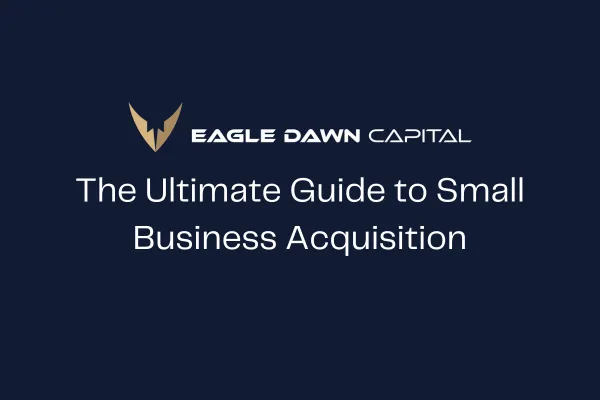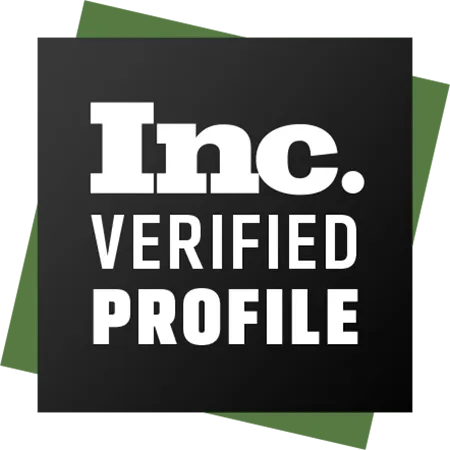
The Ultimate Guide to Small Business Acquisition
Acquire, optimize, and grow an existing business with confidence—your roadmap to turnkey entrepreneurship.
Introduction
Purchasing an existing small business is one of the fastest routes to entrepreneurship. Instead of battling startup risks—building brand awareness, hiring and training staff, and establishing operational systems—you step into a proven model with established cash flow, processes, and customers. This comprehensive guide walks you through every stage of a successful small business acquisition: from defining your acquisition criteria to closing the deal and driving post‑acquisition growth.
At Eagle Dawn Capital, we partner with buyers to source off‑market opportunities, perform deep due diligence, negotiate favorable terms, and ensure a smooth transition. Whether you’re an aspiring entrepreneur, an active investor, or a corporate professional seeking a strategic acquisition, this guide equips you with the frameworks, checklists, and best practices you need.
1. Why Acquire Instead of Start?
Instant Cash Flow: Buy into a revenue-generating operation from day one, mitigating the extended runway required for startups.
Proven Business Model: Validate demand, pricing, and operations based on historical performance.
Established Brand & Customer Base: Leverage existing loyalty and market reputation.
Financing Leverage: Lenders often view acquisitions as lower risk compared to startups.
By acquiring, you channel your time and capital into growth initiatives—scaling operations, expanding into new markets, or optimizing profitability—rather than building from scratch.
2. Define Your Acquisition Criteria
Clearly articulating your goals and target profile sharpens your search and accelerates deal flow:
Industry & Geography: Which sectors align with your expertise? Local geography or remote-operable businesses?
Size & Financial Profile: Revenue range, EBITDA margins, historical growth.
Business Model: Asset‑light vs. asset‑heavy; recurring revenue vs. project‑based.
Risk Tolerance & Investment Horizon: Comfort with turnaround situations or preference for stable cash cows.
Document these criteria in a one‑page acquisition brief to share with brokers, advisors, and your internal team.
3. Deal Sourcing & Opportunity Identification
Top sources for small business deals:
Off‑Market Networks: Confidential outreach to owners via email or phone; leveraging industry contacts and trade associations.
Business Brokers & M&A Advisors: Listings on portals like BizBuySell, Qualify Champions; broker relationships can open exclusive deals.
Direct Mail & Digital Campaigns: Targeted letters or LinkedIn outreach to owners matching your criteria.
Auctions & Intermediaries: Niche auctions for distressed or bank‑owned businesses.
Diversify your sourcing channels to maintain a robust pipeline and uncover hidden gems.
4. Initial Screening & Financial Modeling
Once you identify a potential target, perform a rapid, high‑level assessment:
Validate Seller’s Financials: Review P&L, balance sheet, cash flow for the past 3–5 years.
Key Metrics: Revenue growth rate, EBITDA margin, customer concentration, working capital trends.
Red Flags: Pending litigation, supplier dependencies, high owner compensation, rising accounts receivable.
If the business clears the initial filter, build a simple three‑statement model projecting revenue, expenses, and cash flows under base, upside, and downside scenarios.
5. Deep Due Diligence
Comprehensive due diligence uncovers risks and validates your assumptions:
5.1 Financial Due Diligence
Quality of Earnings: Normalize one‑time expenses and discretionary owner perks.
Tax Returns vs. Book Profits: Reconcile differences.
5.2 Operational Due Diligence
Processes & Systems: SOPs, technology stack, inventory management.
Supplier & Customer Contracts: Terms, renewal schedules, concentration.
5.3 Legal & Compliance
Contracts & Leases: Ownership of intellectual property, lease assignments.
Pending Claims: Employment disputes, environmental liabilities.
5.4 Human Resources & Culture
Org Chart & Roles: Key employee retention plans.
Cultural Fit: Alignment with your leadership style.
Document findings in a due diligence report, categorizing risks by severity and mitigation strategy.
6. Valuation & Deal Structuring
Valuation Methods
EBITDA Multiple: Most common for profitable SMEs. Typical ranges: 3–6× EBITDA (varies by industry).
Discounted Cash Flow (DCF): Projects future free cash flow discounted to present value.
Asset‑Based: Net asset value, often for asset‑heavy businesses.
Deal Structures
Asset Purchase vs. Share Purchase: Tax implications for buyer and seller.
Purchase Price Allocation: Allocating value to assets (goodwill, equipment, IP).
Tax Considerations
Depreciation & Amortization Benefits: Step‑up in basis reduces taxable income.
State & Local Transfer Taxes: Factor into closing costs.
7. Financing Your Acquisition
A diversified financing plan optimizes cost of capital:
Bank Term Loan: Low interest, paid back over 5 to 10 years. 60 to 70% loan-to-value (LTV), with covenants and a personal guarantee.
SBA 7(a) Loan: Up to 90% guaranteed by the SBA. Typically WSJ prime + 3% variable rate that adjusts each quarter.
Seller Financing: Helps reduce the cash needed upfront. Interest can be 0% to 8%, with terms of 1 to 5 years and a balloon payment.
An earnout lets you pay part of the cost based on future performance. This is structured over 1 to 3 years, which lowers risk. An equity co-investment shares the risk with investors. However, it dilutes ownership and does not require debt service
Working with Eagle Dawn Capital, clients secure optimal mixes of SBA, bank, and seller financing to maximize leverage and preserve cash.
8. Negotiation & Letter of Intent (LOI)
A strong LOI sets the framework:
Key Terms: Purchase price, allocation, financing contingencies, exclusivity period (no-shop clause).
Contingencies: Financing approval, satisfactory due diligence, lease assignment.
Deadlines: Due diligence window, closing date.
Negotiate with transparency—clarify deal breakers early and preserve goodwill for a collaborative closing.
9. Closing Checklist
✅ Finalize purchase agreement and schedules
✅ Secure financing commitments and funding wire instructions
✅ Assign or novate key contracts and leases
✅ Resolve outstanding carve‑out liabilities
✅ Execute escrow or holdback arrangements
✅ Transfer licenses, permits, and intellectual property
10. Post-Acquisition Integration & the 100-Day Plan
Successful acquisitions hinge on rapid integration:
Leadership Alignment (Days 1–30): Meet with key employees and customers; communicate vision.
Operational Optimization (Days 31–60): Implement quick-win efficiencies in procurement, staffing, and cost controls.
Growth Initiatives (Days 61–100): Roll out cross‑selling, marketing campaigns, and new product/service expansions.
Track performance against KPIs—revenue, gross margin, cash conversion cycle, employee turnover—and adjust strategies in real time.
11. Common Pitfalls & How to Avoid Them
Overpaying: Ground valuations in multiple methods and third‑party appraisals.
Incomplete Due Diligence: Engage experienced advisors and legal counsel.
Cultural Misalignment: Prioritize team chemistry and communicate early.
Financing Gaps: Pre‑qualify multiple financing sources before LOI.
At Eagle Dawn Capital, our proprietary risk matrix and integration frameworks help clients sidestep these traps.
Frequently Asked Questions
Q1: What size business should first‑time buyers target?
Most buyers start in the $1–5 million revenue range with EBITDA of $200 000 – $500 000, balancing affordability and predictable cash flow. Factors such as available capital, industry experience, growth strategy, and risk tolerance can expand or narrow this range.
Q2: How long does the acquisition process take?
When working with Eagle Dawn Capital, the typical timeline is 6 – 9 months end to end—6 months for standard deals and up to 9 months for more complex targets. First‑time buyers conducting self‑directed searches may take 12 – 24 months to locate, evaluate, negotiate, and close.
Q3: What financing options are available to buyers?
Bank Term Loans: 60 – 70% loan‑to‑value (LTV), amortizing over 5 – 10 years, requiring personal guarantees and covenants.
SBA 7(a) Loan: Up to 90% guaranteed by the SBA. Typically WSJ prime + 3% variable rate that adjusts each quarter.
Seller Financing: Often 10 – 30% of the purchase price, structured over 1 – 5 years, sometimes with a balloon payment.
Earnouts: Portion of purchase price contingent on future performance, aligning seller incentives with growth.
Equity Co‑Investment: Brings in outside investors in exchange for minority equity, reducing debt load.
Q4: What documents are required for due diligence?
Typical due diligence documents include:
Historical financial statements (P&L, balance sheet, cash flow) for 3 – 5 years
Federal and state tax returns
Customer and supplier contracts
Lease agreements, real estate deeds, and equipment titles
Corporate formation documents, shareholder agreements, and bylaws
Employee agreements, benefit plans, and organizational chart
Intellectual property registrations and licenses
Insurance policies and claim history
Q5: Can I withdraw equity from the business after closing?
Post‑closing distributions depend on:
Debt Covenants: Lenders may restrict distributions until certain debt ratios are met.
Cash Flow: Sufficient operating cash flow must remain to fund working capital and debt service.
Tax Considerations: Distributions are subject to corporate or owner‑level tax implications.
Structured Payments: Earnouts or seller notes may limit early equity withdrawals.
Q6: Do I need industry experience to acquire a business?
While relevant industry experience can ease transition and risk management, buyers without direct experience can succeed by:
Partnering with experienced operators or management teams
Engaging industry‑specific advisors during due diligence
Investing in training and operational support post‑closing
Focusing on businesses with transferable skill requirements
Q7: How do I negotiate a purchase price?
Key strategies include:
Valuation Multiples: Benchmark EBITDA multiples within the industry.
Normalized Earnings: Adjust seller’s discretionary earnings for one‑time items.
Contingency Structuring: Use earnouts to bridge valuation gaps.
Competitive Bidding: Solicit multiple offers to establish market price.
Q8: What fees and closing costs should I expect?
Common fees include:
Broker commissions (5 – 10% of sale price)
Legal and accounting fees ($10 000 – $50 000 total)
Lender origination and appraisal fees (1 – 3% of loan amount)
Escrow, title insurance, and transfer taxes
Due diligence expenses (environmental assessments, third‑party reports)
Q9: What is the role of a Letter of Intent (LOI)?
An LOI:
Outlines key deal terms (price, structure, contingencies)
Secures exclusivity (no‑shop clause)
Defines due diligence timeline and closing date
Serves as a roadmap for drafting the definitive purchase agreement
Q10: When should I engage professional advisors?
Engage early to avoid pitfalls:
M&A Advisor or Broker: During deal sourcing and valuation
CPA or Financial Advisor: Before modelling and tax planning
M&A Attorney: Prior to LOI drafting and closing
Operational Consultant: For post‑acquisition integration planning
Conclusion & Next Steps
Acquiring a small business offers a turnkey path to entrepreneurship—leveraging proven operations, established cash flow, and growth upside. By following this guide’s disciplined roadmap, you’ll make informed decisions, negotiate optimal terms, and integrate seamlessly.
Ready to explore off‑market acquisition opportunities and craft a tailored financing strategy? Contact Eagle Dawn Capital today for a no‑obligation consultation. Let our expertise accelerate your entrepreneurial journey.
Disclaimer: This guide is for informational purposes only and does not constitute legal or financial advice. Always consult qualified professionals before making acquisition decisions.




Facebook
Instagram
X
LinkedIn
Youtube